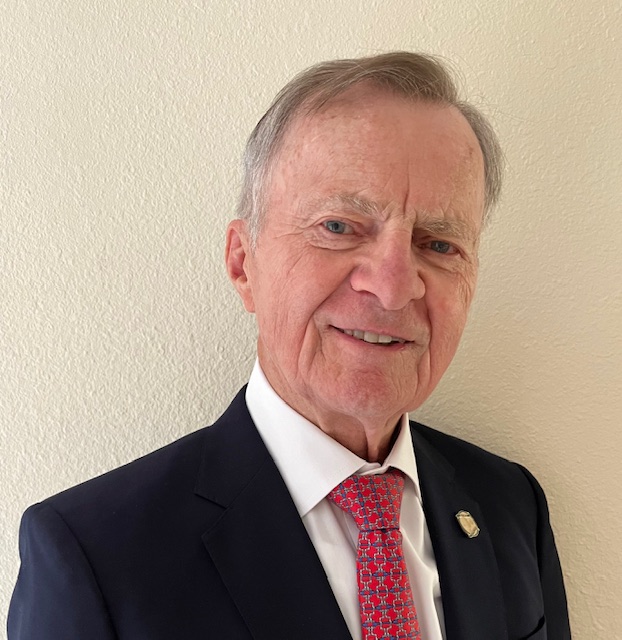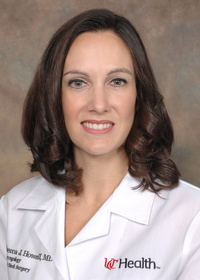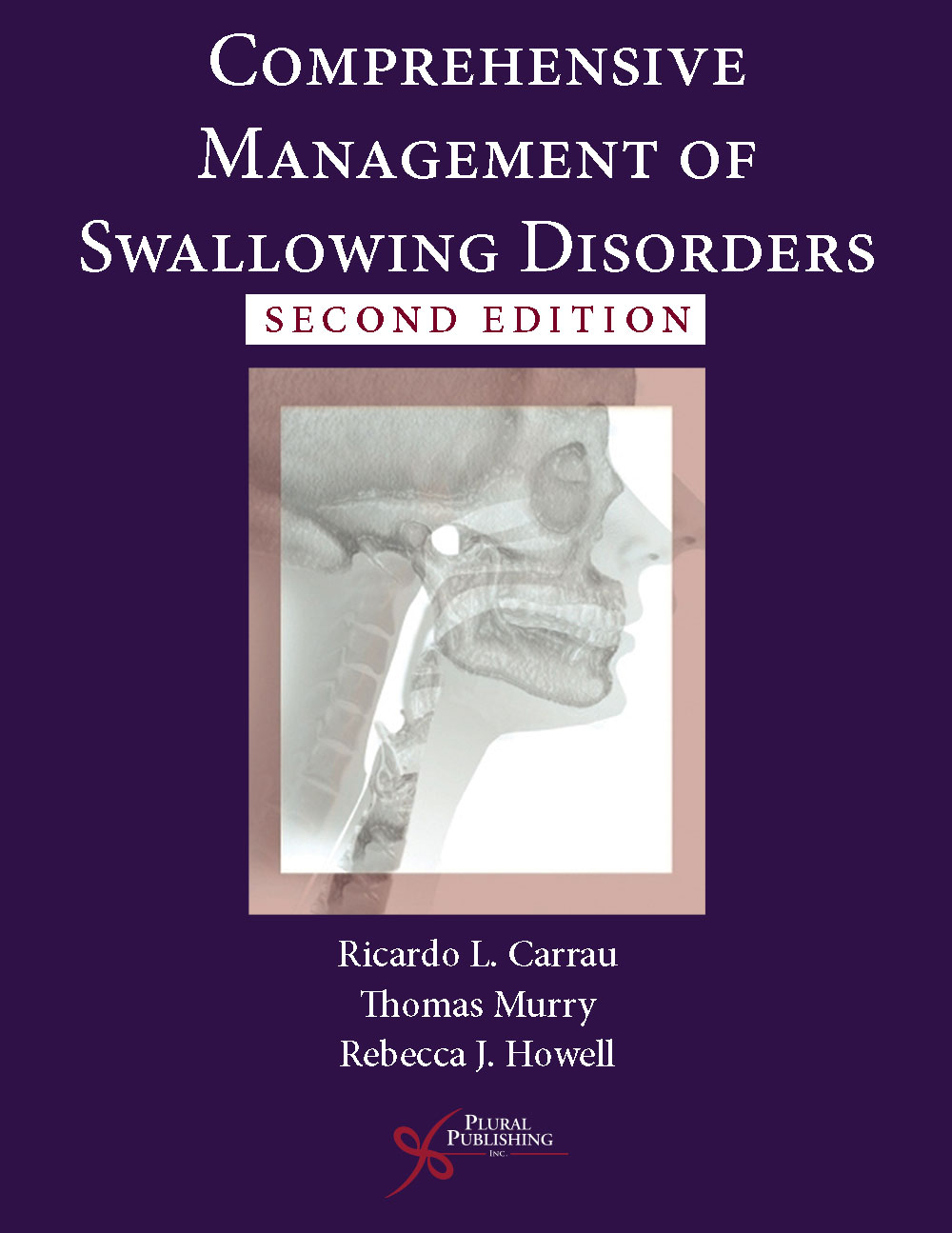
Comprehensive Management of Swallowing Disorders
Second Edition
Ricardo L. Carrau, Thomas Murry, Rebecca J. Howell
Details: 576 pages, B&W, Softcover, 8.5" x 11"
ISBN13: 978-1-59756-730-5
© 2017 | Available
For Instructors
Purchase
Comprehensive Management of Swallowing Disorders, Second Edition has been revised with new authors and expanded information on the clinical evaluations made by dysphagia specialists and with state-of-the-art medical, behavioral, and surgical treatment options. The editors have selected specialists in every swallowing-related discipline to bring this edition to a true "state-of-the-art" comprehensive text on dysphagia. The text meets the needs of students, scientists, and practitioners who are involved daily with the complex issues of dysphagia.
It is divided into seven main parts:
- Part I. Introduction
- Part II. Anatomy and Physiology of Swallowing
- Part III. Evaluation: A. Clinical Evaluation
- Part III. Evaluation: B. Functional Tests
- Part IV. Pathophysiology of Swallowing Disorders
- Part V. Nonsurgical Treatment of Swallowing Disorders
- Part VI. Surgical Treatment of Swallowing Disorders
- Part VII. Swallowing Disorders: Prevalence and Management in Special Populations
Each section has been carefully edited with up-to-date references and provides the reader with a host of new material related to diagnosis, testing, and management of swallowing disorders. The authors represent the current core of those involved in multidisciplinary swallowing centers, and each focuses on his or her area of specialization. They bring their own perspective on the issues and challenges they face in managing swallowing disorders, knowing that other specialists are equally involved. This single volume is intended for practicing clinicians, students, and research scientists and represents up-to-date information in each area of specialization.
Special Features
- Details extensive discussions of normal swallow in pediatric and adult populations
- Provides concise outlines of specific clinical examinations by seven clinical specialists: Otolaryngology, Speech Pathology, Rehabilitation Medicine, Neurology, Gastroenterology, Pediatrics, and Nutrition
- Describes a variety of treatments offered by many different specialties, including prosthodontists, speech-language pathologists, infectious disease specialists, and pediatricians
- Brings issues of diet and nutrition up to date within the international dysphagia diet guidelines
- Features a multidisciplinary team approach blended throughout the text that reflects the needs of the patients with swallowing disorders
Reviews
"Comprehensive Management of Swallowing Disorders addresses the overall diagnosis and management of swallowing disorders in a large variety of clinical situations. The textbook is divided into 7 parts, each of which contains multiple specialized chapters. The text begins with an introduction to swallowing disorders and anatomy and physiology of swallowing. It progresses into the evaluation of swallowing disorders from both a clinical and objective standpoint. Each part thereafter focuses on the pathophysiology of swallowing disorders, including a plethora of etiologies evident in a variety of settings, but most commonly in the acute care hospital.
The textbook discusses both surgical and nonsurgical treatments of swallowing disorders including another array of clinical situations. The textbook concludes with a few short chapters on the management of dysphagia in specialized populations. The chapters on the pathophysiology of swallowing disorders really help the reader understand the cause of the swallowing impairment to better manage these patients. The described etiologies are prevalent in any hospital setting and even outpatient care. This work utilizes functional pictures and applicable, thought-provoking questions to promote learning.
This work is relevant for any health care professional involved in managing patients with swallowing disorders. It would be most applicable to otorhinolaryngology residents and physician assistants and nurse practitioners who work within an otorhinolaryngology department. This text would also be a great resource for physiatrists, who also help manage these patients with swallowing disorders. From a speech pathology perspective, this textbook is a nice resource for a student/newer clinician as opposed to a seasoned clinician."
—Gina L. Palma, MS, CCC-SLP, BCS-S, Bronx, New York, USA, in the Annals of Otology, Rhinology & Laryngology, Vol. 126(6) (2017)
"Disorders of swallowing feature in the ISCP Otolaryngology syllabus as part of the Head and Neck category. Although grouped into one discrete subject, the specific learning points are far more disparate. The Comprehensive Management of Swallowing Disorders by Carrau et al. proves to be a worthy compendium in understanding this topic. Now in its second edition, this paperback book comes packed with information on swallowing disorders, distilled into 550 pages.
Following a rousing foreword by Professor Peter Belafsky, the text is divided into seven parts breaking the topic of swallowing disorders into sections such as clinical evaluation, functional testing, pathophysiology, surgical and medical management. The final part is concerned with dysphagia in special populations: including children and the elderly. The chapters, by and large, are well-written in a concise manner that is easy to follow. The multidisciplinary nature of dysphagia management is made very apparent in the third part, where the perspectives and different roles that other healthcare professionals play is considered through their own specific chapters. Chapters on "the normal swallow" and functional tests in evaluation are particularly useful and well explained. Some other chapters tend to move further away from an otolaryngological perspective and may be more useful as "good to know" information. . . . . This book will prove valuable as a reference text when studying the topic of dysphagia, especially to a higher level. It will also prove of equal worth for our colleagues in speech and language therapy and gastroenterology—to name but a few."
—Rohit Gohil, Dept. of Otorhinolaryngology, Lauriston Building, Edinburgh, in the Journal of Laryngology & Otology (Jan 2017)
"I often start a book by looking at the authors and contributors and their credentials. The majority of these contributors are all senior professors within various university hospitals in the US, and few quick literature and google searches indicate they are all highly respected within their fields. The book itself is divided into seven parts and then further subdivided into chapters. This makes it very easily digestible and quick when looking for something in particular. The parts are sequential (like a patient journey) from anatomy to clinical evaluation, pathophysiology and treatment. The final part covers specialist areas such as paediatrics and critical care patients. The text is very well-written in an easy-to-read format and, quite importantly, from a multidisciplinary team perspective. It is very evidence-based with all points referenced to journal articles, which appear at the end of each chapter. There is not a huge number of pictures or photographs, but those present are very relevant e.g. barium swallow and endoscopic findings. In summary, my short review is unable to do this book justice. I would suggest it is useful as background reading and a reference book for ENT trainees but a must-have for anybody with a 'comprehensive' interest in swallowing disorders."
—Omar Mulla, ENT Specialist Trainee, Doncaster Royal Infirmary, UK, in ENT & Audiology News (May/June 2017)
"...one of the most comprehensive books on dysphagia. Its contents inform on the nature of swallowing, the etiology of relevant disease, evaluations, diagnosis and interventions for swallowing problems in adults. It could thus be useful for nutritionists and dietitions, pediatricians, occupational therapists, gastroenterologists, otorhinolaryngologists, neurologists, surgeons, speech and language pathologists, and families of patients with swallowing problems. This second edition textbook is divided into seven sections that each address a fundamental knowledge gap, providing a comprehensive foundation from which future treatment innovation can be made."
—Shamim Ghazi, Department of Speech Therapy, School of Paramedical Sciences, Mashhad University of Medical Sciences, Mashhad, Iran, World Nutrition journal (March 2022)
Foreword
Preface
Acknowledgments
Contributors
Part I. Introduction
Chapter 1. Epidemiology of Swallowing Disorders
Thomas Murry, Ricardo L. Carrau, and Rebecca J. Howell
Part II. Anatomy and Physiology of Swallowing
Chapter 2. The Organs of Swallowing
David E. Eibling
Chapter 3. The Normal Swallow
Rebecca J. Howell
Part III. Evaluation: A. Clinical Evaluation
Chapter 4. The Otolaryngologist's Perspective
Ricardo L. Carrau and Rebecca J. Howell
Chapter 5. Speech-Language Pathology: The Clinical Swallow Examination
Christina V. Nobriga and Thomas Murry
Chapter 6. Clinical Evaluation of Swallowing Disorders: The Pediatric Perspective
Charles M. Myer IV
Chapter 7. Evaluation of Swallowing: The Gastroenterologist's Perspective
Andrew Lake and Satish S.C. Rao
Chapter 8. The Neurologist's Perspective
Kathleen M. Sarber
Chapter 9. Multidisciplinary Team Approach to the Management of Dysphagia
Winston T. Cheng
Chapter 10. The Registered Dietitian/Nutritionist's Perspective
Shayne Robinson
Chapter 11. Evaluation of Dysphagia: A Surgeon's Perspective
Ivy N. Haskins and Khashayar Vaziri
Part III. Evaluation: B. Functional Tests
Chapter 12. The Radiological Evaluation of Dysphagia: The Barium Swallow
Michael C. Burke, Robert K. Zeman, and M. Reza Taheri
Chapter 13. The Radiographical Evaluation of Dysphagia: The Modified Barium Swallow
Courtney L. Robinson
Chapter 14. Functional Endoscopic Tests of Swallowing
Daniel Weinstein
Chapter 15. Transnasal Esophagoscopy
Christopher M. Johnson and Gregory N. Postma
Chapter 16. Gastroenterological Evaluation of Swallowing
Kulthep Rattanakovit, Tanisa Patcharatrakul, and Satish S.C. Rao
Chapter 17. Laryngeal Electromyography
Steven Bielamowicz
Part IV. Pathophysiology of Swallowing Disorders
Chapter 18. Pathophysiology of Neurogenic Oropharyngeal Dysphagia
James L. Coyle, John C. Rosenbek, and Atsuko Kurosu
Chapter 19. Neuromuscular Disorders
Karen Wheeler Hegland
Chapter 20. Iatrogenic Swallowing Disorders: Chemotherapy
Loni C. Arrese and Panayiotis (Panos) Savvides
Chapter 21. Iatrogenic Swallowing Disorders: Radiotherapy
Dukagjin M. Blakaj, Loni C. Arrese, Virginia M. Diavolitsis, and John C. Grecula
Chapter 22. Dysphagia and Tracheotomy
Rohan R. Joshi and Ashutosh Kacker
Chapter 23. Surgery of the Oral Cavity, Oropharynx, and Hypopharynx
Qasim Husain and Marc A. Cohen
Chapter 24. Pathophysiology of Swallowing Disorders After Laryngectomy
Mahmoud Issam Awad and David I. Kutler
Chapter 25. Dysphagia Associated with Skull Base Surgery
C. Arturo Solares and Ricardo L. Carrau
Chapter 26. Thyroid Surgery
David L. Steward
Chapter 27. Swallowing Disorder After Cervical Spine Surgery
David Dornbos III, Nolan B. Seim, and Ehud Mendel
Chapter 28. Disorders of Esophageal Motility
Roberta J. Hunter
Chapter 29. Zenker and Other Esophageal Diverticula
Rebecca J. Howell and John Paul Giliberto
Chapter 30. Autoimmune Disorders
Saravanan Thiagarajan and Surabhi A. Khanna
Chapter 31. Neoplasia of the Upper Aerodigestive Tract: Primary Tumors and Secondary Involvement
Brianna K. Crawley
Chapter 32. Benign Esophageal Webs and Strictures
Ashli ORourke
Chapter 33. Cardiopulmonary Disorders
Abhimanyu Saini and Ashima Sahni
Chapter 34. Infectious Diseases
Kelli McCauley and Rajat Madan
Part V. Nonsurgical Treatment of Swallowing Disorders
Chapter 35. Diet Modifications
Shayne Robinson
Chapter 36. Nonsurgical Therapeutic Intervention for Swallowing Disorders
Thomas Murry and Karen Wheeler Hegland
Chapter 37. Dental Prosthetics
Rebecca Leonard
Chapter 38. Passy-Muir Valve/Decannulation
Roxann Diez Gross, Lauren Dorn Enloe, and Stephanie Eleazar Reyes
Part VI. Surgical Treatment of Swallowing Disorders
Chapter 39. Tracheostomy
Paul M. Weinberger and Rebecca J. Howell
Chapter 40. Vocal Fold Injection
Brad W. deSilva and Laura Matrka
Chapter 41. Laryngeal Framework Surgery: Medialization Laryngoplasty
Robert J. Andrews, James L. Netterville, and Albert L. Mercati
Chapter 42. Cricopharyngeal Myotomy
Marsha S. Reuther and Gregory N. Postma
Chapter 43. Palatal Adhesion/Pharyngeal Flap
James L. Netterville
Chapter 44. Management of Intractable Aspiration
Maggie A. Kuhn
Chapter 45. Gastrostomy
Edward L. Jones and Jeffrey W. Hazey
Chapter 46. Surgical Management of Zenker and Other Esophageal Diverticula
Rebecca J. Howell and John Paul Giliberto
Chapter 47. Esophagectomy for Swallowing Disorders
Winifred M. Lo and Valerie A. Williams
Chapter 48. Motility Disorders of Esophagus and Surgical Interventions
Melanie H. Howell and Erin Moran-Atkin
Chapter 49. Gastroesophageal Reflux Disease: Surgical Management and Other Novel Therapies
Hope T. Jackson and Khashayar Vaziri
Part VII. Swallowing Disorders: Prevalence and Management in Special Populations
Chapter 50. Pediatric Dysphagia: Disorders of Swallowing and Feeding
Justin C. Cohen and Thomas Murry
Chapter 51. Swallowing Disorders in the Critical Care Patient
Bernice K. Klaben and Heidi Schieve
Chapter 52. Dysphagia in the Elderly
David E. Eibling and James L. Coyle
Chapter 53. Aspiration Pneumonia
Priya D. Krishna
Chapter 54. Expiratory Muscle Strength Training as a Therapy Modality
Christine M. Sapienza, Bari Hoffman Ruddy, Erin P. Silverman, and Emily K. Plowman
Index
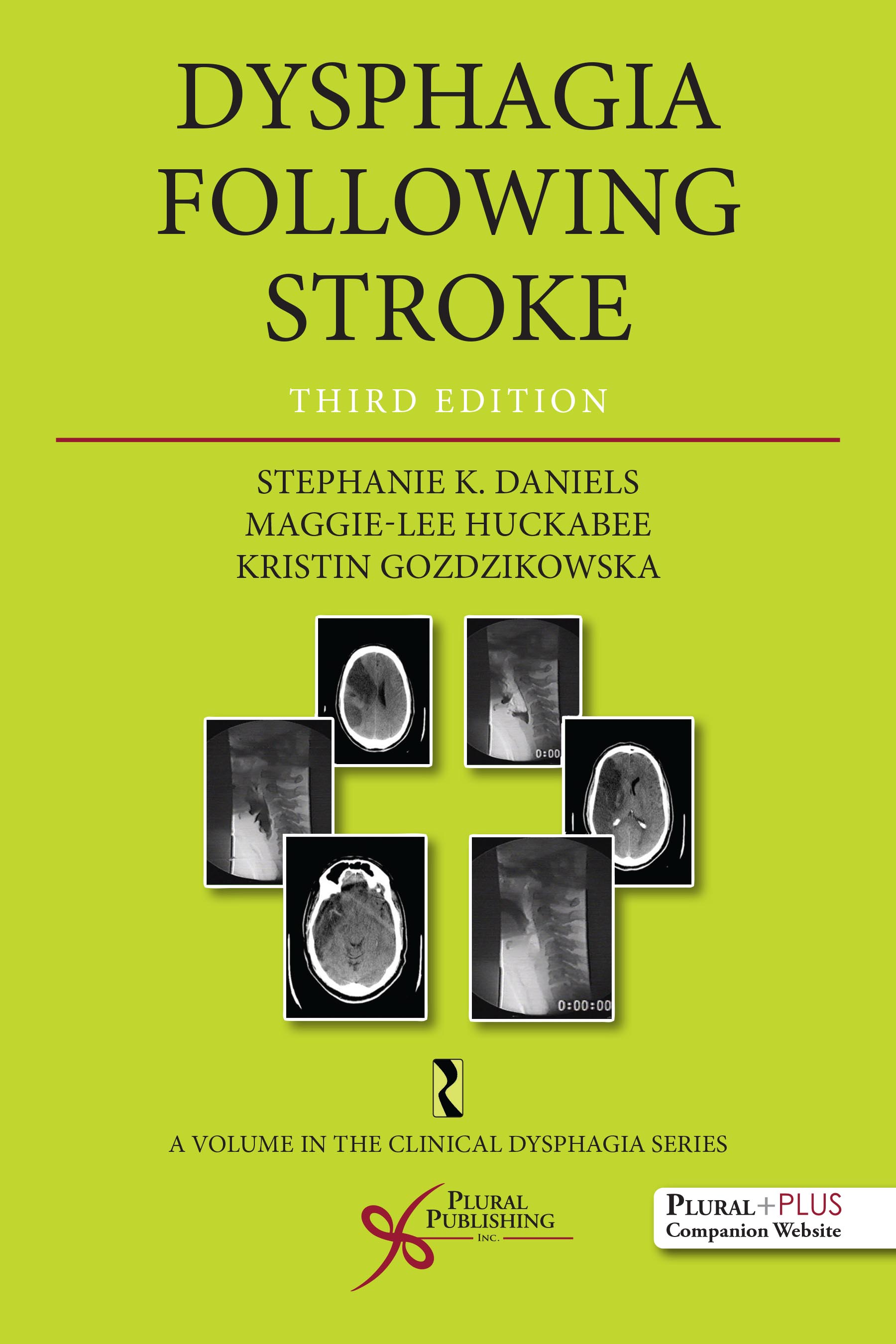
Dysphagia Following Stroke
Third Edition
Stephanie K. Daniels, Maggie-Lee Huckabee, Kristin Gozdzikowska
Details: 500 pages, B&W, Softcover, 6" x 9"
ISBN13: 978-1-63550-030-1
© 2019 | Available
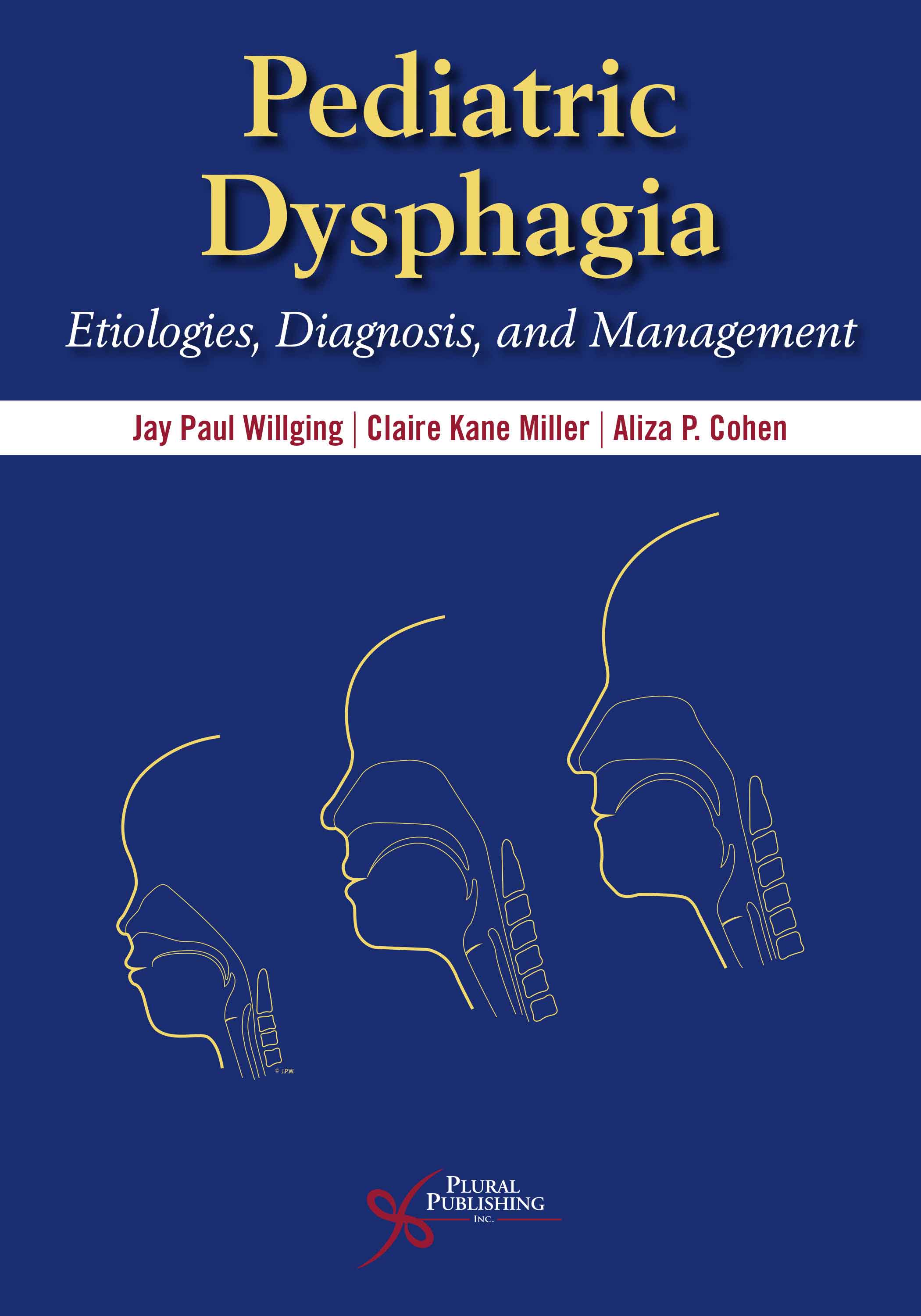
Pediatric Dysphagia: Etiologies, Diagnosis, and Management
First Edition
Jay Paul Willging, Claire Kane Miller, Aliza P. Cohen
Details: 720 pages, Full Color, Hardcover, 7" x 10"
ISBN13: 978-1-59756-864-7
© 2020 | Available

The Adult Dysphagia Pocket Guide: Neuroanatomy to Clinical Practice
Second Edition
Yvette M. McCoy, Tiffani Wallace
Details: 227 pages, B&W, Spiral Bound, 4.5" x 8"
ISBN13: 978-1-63550-771-3
© 2026 | Available


